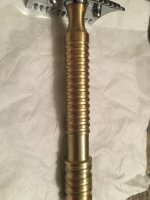I cleaned some of my razors with Barbicide last night. Tonight, I was looking at my WCS 79BR, which I cleaned last night. It looks like whatever WCS uses to coat the handle to prevent tarnishing reacted with the Barbicide and became slightly blue. It's not a big deal, and the blue can be scraped off (though, I suspect this also removes the tarnish preventing coating).
Attachments
Last edited:






